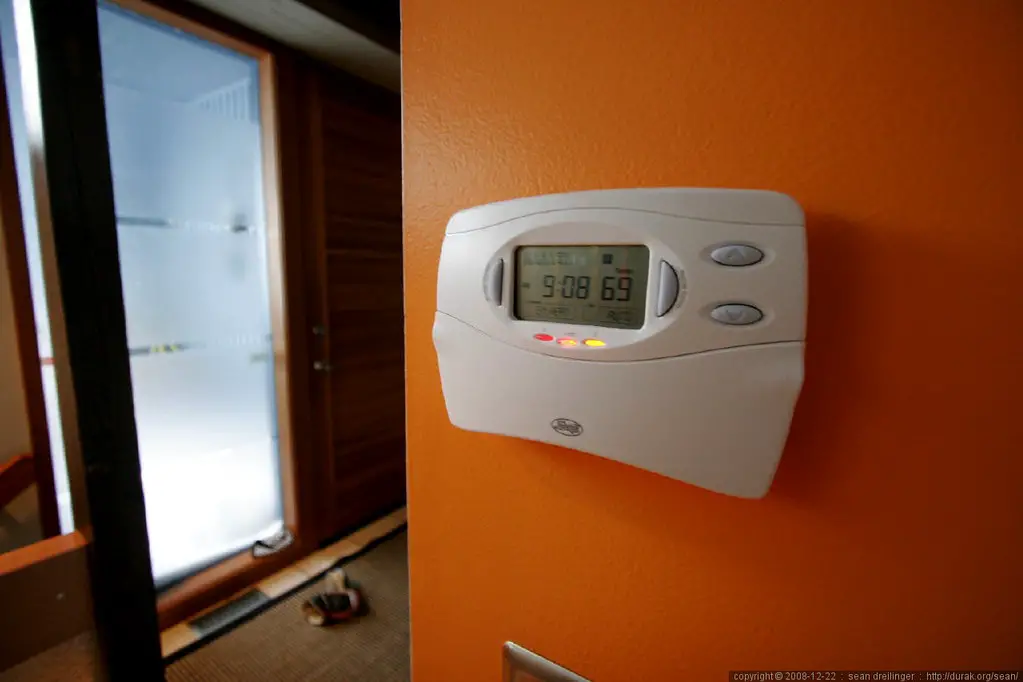Check Best Thermostat Pricing in Amazon
** As an Amazon Associate, I earn from qualifying purchases.
Emergency heat on your thermostat should be used when your heat pump isn’t functioning properly due to extremely cold weather conditions. It’s a backup system that prevents your home from becoming excessively cold. Ensure that you consult an HVAC professional if emergency heat usage continues for an extended period.
When to Use Emergency Heat on Thermostat?
The name’ Emergency Heat’ might imply that this option should only be activated in catastrophic situations, but that’s not true. If you’re using a heat pump system, the emergency heat setting comes in handy when the outdoor temperature drops below the heat pump’s capacity to provide heat efficiently. Some experts suggest using this setting only when outdoor temperatures drop below freezing (32°F or 0°C).
A heat pump will normally pull heat from the outside air to warm your home. However, when the temperature drops too low, the heat pump may struggle to extract enough heat. In this case, turning on the emergency heat manually can help. This function activates the supplemental heating element in the system, which usually takes the form of electric resistance heat—much like a built-in space heater.
Remember that while the emergency heat setting can provide the necessary warmth when your heat pump can’t cope, it is not designed to be used daily. Since the backup heat source uses significantly more energy than the heat pump, frequent usage can lead to higher energy costs.
It’s also important to note that different heat pump models have varying efficiency levels. Some models may still provide adequate heat even when outdoor temperatures drop below freezing. Therefore, enabling the emergency heat setting in these instances may not be necessary.
Possible Indication of HVAC System Issues
If your system runs on emergency heat frequently, it could indicate underlying HVAC system issues. The thermostat will automatically switch to emergency heat if the heat pump can’t keep up or there are issues with the outdoor unit.
Such problems could be faulty reversing valves, a freezing outdoor unit, coolant shortages, or defrost cycle problems. Prolonged use of emergency heat also strains the heating system, leading to more wear and tear and potential problems. If you suspect an issue with your heat pump, it’s best to call a professional for diagnostic and repair services.
Performing regular maintenance can prevent the need for frequent emergency heat use. This includes regularly changing air filters, checking refrigerant levels, and clearing debris around the outdoor unit.
Increasing Heat Pump Efficiency
Even if you understand when to use emergency heat on the thermostat, conserving energy should be a priority. You can enhance your heat pump’s efficiency by ensuring it is correctly sized for your home. An undersized system will need to work harder, while an oversized one cycles on and off too frequently, leading to increased wear and tear.
Check Best Thermostat Pricing in Amazon
** As an Amazon Associate, I earn from qualifying purchases.
Regularly servicing your heat pump can help maintain its peak operating efficiency. This includes cleaning the coils, checking the refrigerant level, and ensuring the fan functions properly. You could opt for a professional to handle all these tasks or take the DIY route if you’re comfortable handling these basics of HVAC system maintenance.
Improving the insulation in your home can also help maintain a consistent indoor temperature. This reduces the need to overwork the heat pump, reducing the need for emergency heating. Areas to focus on include windows, doors, and the attic space.
Programmable thermostats can also significantly enhance your heating system’s efficiency. These devices allow you to customize your home heating schedule, ensuring the heat pump only works when necessary. Therefore, they save energy and reduce the reliance on emergency heat.
Selecting the Right Thermostat
The type of thermostat you use in your home is essential to heating efficiency. While traditional thermostats are still viable, newer models, such as smart thermostats, offer more customizable options for home heating.
Smart thermostats take programmability to a new level. Many models integrate with your smartphone, enabling you to adjust your home’s temperature remotely. They can also learn your schedule and preferences, automatically adjusting to optimize efficiency and comfort. While they might cost more upfront, their benefits in terms of energy savings can pay for the initial outlay over time.
When selecting a thermostat, consider your home’s heating needs, the HVAC equipment you use, and your schedule. Some thermostats, for instance, are designed to work specifically with heat pump systems and provide options for emergency heat settings.
An efficient heating strategy goes beyond understanding when to use the emergency heat on your thermostat. Ensuring your heating system is well-maintained and optimized for your home’s specific needs makes it possible to stay warm and comfortable throughout the cold season while keeping energy costs at bay.
Check Best Thermostat Pricing in Amazon
** As an Amazon Associate, I earn from qualifying purchases.
Key Takeaways
- Emergency heat should be used when the primary heat system fails.
- It is a backup system designed for sudden heating needs.
- Unusually cold weather may necessitate its use for comfort.
- The usage of emergency heat can result in increased energy costs.
- Regular maintenance checks can prevent unnecessary use of emergency heat.


